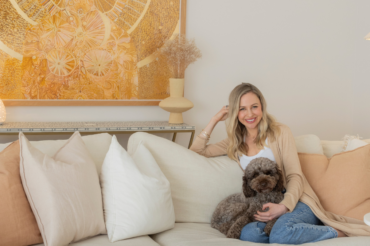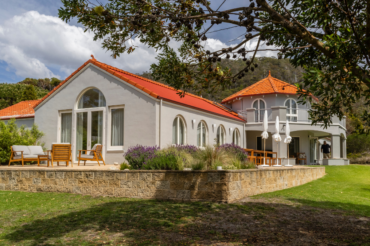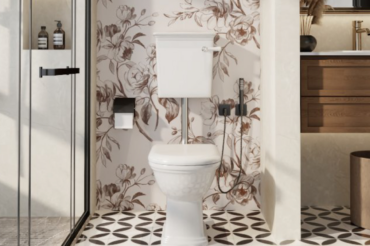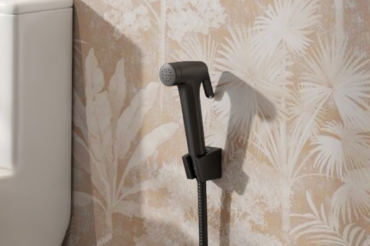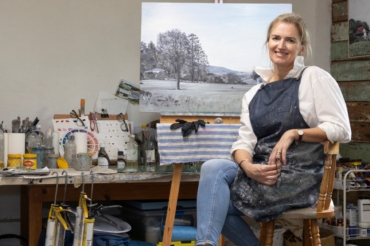
As Claire Ayling sees it, moving to Goulburn was fate. If she hadn’t been a patchwork quilter, she would never have been trawling around on the internet, checking out the provincial NSW city, where a quilting friend lived. And she would never have stumbled across the 1840s former guesthouse, Mandelson’s of Goulburn, on a real estate site. And she and her Australian army officer husband, Steve, would never have become the proud owners of the Goulburn landmark building and put down roots after a lifetime on the road.
The self-confessed English nomad met Steve when she was teaching British army children. They married in 1979 and she calculates that during Steve’s 30 years in the military they moved 31 times, three of them when she was eight months pregnant, with their now adult children.
Steve’s career meant the family lived all over the world from postings in Australia to bases as diverse as Pakistan, Germany and Cambodia.
But it was Steve’s final overseas gig, to Carlisle, Pennsylvania, home of the US Army War College, the most senior military educational facility in the US, that proved a game changer for Claire. “Steve was off studying and the kids were in school, so I had lots of time on my hands,” she recalls. “So I used to take myself off exploring. One day I went to Lancaster, where America’s oldest plain-living Amish community lives and I met a woman called Hannah, who ran a quilt shop from her home. It turned out to be a meeting of like minds and I visited her every Tuesday for a year. It was a fascinating insight into their unmechanised society and she introduced me to all facets of quilting and taught me a lot about colour.”
So by the time the Aylings returned to Australia, Claire had a well-established quilting hobby, and connected with one of Australia’s leading artists, Julie Woods. Who just happened to live in Goulburn. The rest, as they say, is history.
“When I stumbled across Mandleson’s it was being run as a B&B,” Claire explains. “It had been very lovingly restored by the previous owners, Noel and Renate Johnson-Barrett, and they have become firm friends of ours. So we took over the business and at first continued to do bed and breakfast, while we lived in a ’70s extension out the back. But then we realised the folly of our guests getting to enjoy the best part of the house and we switched it around and created three self-catering apartments at the back and we moved into the front part. So now we get to enjoy the grand old building and still have a business, but one that
is not as demanding as a B&B.”
The land on which Mandelson’s stands is the site of Goulburn’s first hut, built by a Mr King. In 1837 the land was sold to John (Jack) Cole for £1 on the proviso that he build a dwelling to the value of £20 on the site. Cole proceeded to build the Goulburn Hotel, which he sold in 1840 to Nathan Mandelson.
Thus Mandelson’s Hotel, reputed to rival the best establishments in Sydney, came into being, a centre for meetings and entertainment, with what were claimed to be the best stables in Goulburn. During the 1840s and ’50s a Who’s Who of the community passed through the doors, including community leaders lobbying for the construction of a railway line from Sydney. When that line was finally completed in 1869, Mandelson’s hosted the then NSW governor and his wife, Earl and Lady Belmore, as they officiated at the opening of the railway station across the road. Between 1854 and ’58 several downstairs rooms became the offices of lawyer Daniel Henry Deniehy, the first native-born Australian admitted to the bar and a fierce advocate of republicanism. During his occupancy in the premises he penned numerous letters advocating for federation of the states and furthering his campaign against privilege for squattocracy, for whom he coined the term, bunyip aristocracy. By 1863, Goulburn had been decreed Australia’s first inland city by Queen Victoria. “In those days if you had a university or a cathedral you became a city,” Steve explains. “Goulburn has two cathedrals, ergo it’s a city.”
In the 1870s the hotel became the Metcalfe High School and verandahs were added in the 1880s (they were removed 50 years later) and during WWI the premises were returned to a private hotel. Following WWII the building became a boarding house for migrant workers and then in the 1970s it became the Mulwaree Hotel with the extension out the back. It wasn’t until 1999 when the Johnson-Barretts came along that the building was restored to its 1846 heyday, complete with Juliet balconies and a striking pink façade.
As a former builder, Noel painstakingly scraped back the walls to find remnants of the original papers, which were copied in England. Window dressings, furnishings, and the ballroom were restored with similar attention to detail.
“Most of the hard work had been done by the time we came along,” Claire says. “It really is the perfect place to showcase my collections, which include china and vintage costumes and a great backdrop for Steve’s acquistive habits, which are collecting Art Deco pieces and Moorcroft pottery.”
Claire also displays the many quilts she has made through the years throughout the building. Pride of place goes to one created by her Amish friend, Hannah, which Steve bought on a return trip to the US.
“I called on her and explained I wanted to take a quilt back for Claire,” Steve explains. “She was so excited that she sold me a quilt she had been working on for another customer. Hannah said she will just have to wait for another year, because she wanted Claire to have the Cadillac of quilts.”
Claire now runs a small business from home, selling batik fabrics from Bali for quilters and there’s plenty of room in the former conference area for Claire and her quilting friends to meet and work on their projects. “It really has been the most serendipitous experience,” Claire says. “I’ve never had such a sense of belonging as I have since we bought Mandelson’s.”
For more information on the apartments, or Claire’s fabrics, visit mandelsons.com.au.
The complete story was originally published in Australian Country issue 20.6. Click here to subscribe to our magazine
Words Kirsty McKenzie
Photography Ken Brass









